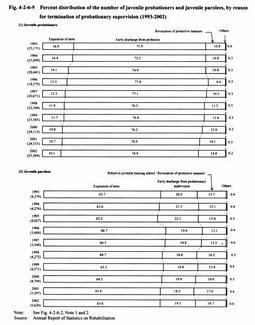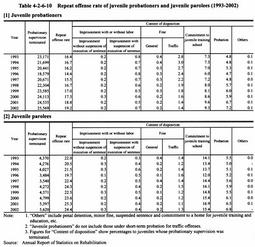| Previous Next Index Image Index Year Selection | |
|
|
6 Result of probationary supervision (1) Situation on termination of probationary supervision Fig. 4-2-6-9 shows the percent distribution of reasons of termination of probationary supervision for juvenile probationers (excluding those under short-term probation for traffic offenses; hereinafter the same in this section) and juvenile parolees in the last 10 years. As regards juvenile probationers, the percentage of those whose probationary supervision is terminated due to early discharge from probation (good-conduct measures) was 74.9% in 2002, or about 3/4ths, indicating that good-conduct measures have been actively taken. Viewing the trends in the last 10 years, the percentage of early discharge from probation was on an upward trend until 1997, and has remained constant thereafter. The percentage of revocation of protective measure has been on a slightly upward trend since 2000.
As for juvenile parolees, the percentage of those whose probationary supervision was terminated due toearly discharge from probationary supervision (good-conduct measures) was 19.3% in 2002. The expiration of term accounted for 63.6% while return to juvenile training school or revocation of protective measure accounted for 16.7%, both of which have registered almost no change in last 10 years. The percentage of juvenile parolees for whom a good-conduct measure has been taken is lower than that for juvenile probationers, reflecting the fact that a considerable number of juvenile parolees have problems. Fig. 4-2-6-9 Percent distribution of the number of juvenile probationers and juvenile parolees, by reason for termination of probationary supervision (1993-2002) (2) Situation of repeat offense Table 4-2-6-10 shows the percentage of juvenile probationers and juvenile parolees who committed repeat delinquency or a repeat offence during their probationary supervision period and were given protective measures (excluding return to juvenile training school) or criminal dispositions, among those whose probationary supervision was terminated (hereinafter referred to as "repeat offense rate") in the last 10 years.
The repeat offense rate generally tended to move downward until 1996 for both juvenile probationers and juvenile parolees. Subsequently, however, as for juvenile probationers, the rate has been on a slightly upward trend since 1997, reaching 19.2% in 2002. On the other hand, as for juvenile parolees, the rate has seen repeated rises and declines, coming to 24.4% in 2002, down 0.9 points from the previous year. Table 4-2-6-10 Repeat offense rate of juvenile probationers and juvenile parolees (1993-2002) Explanation of termsLocal delinquent group: Local delinquent group means a group of juveniles who have a common delinquent culture, which is formulated focusing on the community beyond schools and workplaces. The representative examples are "color gangs" and "teams" in which juveniles wearing the same clothes swagger about in a group. Compared to bosozoku these groups do not have a specific behavioral purpose, and they are not strongly organized, but they do commit snatching, extortion, robbery, etc. in some cases. Revocation of protective measure: A protective measure is taken not on an individual fact of delinquency but on a person, and thus one protective measure exists for one juvenile, in principle. Therefore, a family court may revoke prior disposition (sometimes subsequent disposition) if a new protective measure is taken in response to referral of a new fact of delinquency during the period of the protective measure. Also, if conviction becomes final on a juvenile during the period of the protective measure, the family court may revoke the protective measure. |

